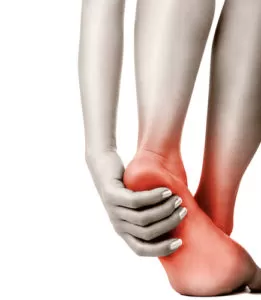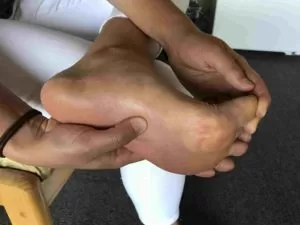“Revolutionary New Way to Get Rid of Plantar Fasciitis and Walk Without Pain”

What is “PLANTAR FASCIITIS”? Plantar Fasciitis refers to inflammation of the band of tissue on the bottom of the foot.
Pain develops and tells the body to minimize motion and irritation in the area leading to limping and difficulty walking.
Typical symptoms include pain with the first few minutes of walking in the morning or pain after standing and walking for prolonged periods.
Going without shoes on hard surfaces can often make the pain worse.
What causes PLANTAR FASCIITIS?
The most common causes are;
1) Flat feet (“fallen arches”).
2) Improper footwear.
3) Sudden increase in activity – more time spent standing and walking.
4) In some cases it occurs with no significant change in activity at all.
Problems it can cause…
It can make it difficult to stand, walk, run and play. This can cause difficulty with many activities including work and exercise.
Physiologically, the pain often stems from…
- Soft tissue inflammation
- Tight calf muscles
- Flat feet
When should I worry?
- If it’s lasting more than 7 days.
- If you’ve taken drugs but it no longer helps.
- If you are having pain with standing and walking making it difficult to perform daily activities.
When does it become urgent?
- If you have pain without putting weight on your foot.
- If your leg muscle begins to shrink (atrophy).
- If you are having difficulty completing daily activities.
If you experience any of these symptoms, call us immediately. Delaying treatment can make is much harder to treat.
Traditional treatments that most try but are not as effective in the long term include:
- Orthotics
- Medications
- Injections
- Generic Physical Therapy
- Massage
- Generic exercises (Youtube, personal trainer)
If left untreated, PLANTAR FASCIITIS can lead to a rupture of the plantar fascia.
A rupture (tearing) of the Plantar Fascia can require prolonged immobilization in a stiff boot and require extensive rehabilitation to get back on your feet. If a tissue is inflamed for long time (chronic inflammation) it becomes weaker and more prone to rupture so seeking a solution sooner rather than later is in your best interest.
Try This Self-Test to See If You Have might have Plantar Fasciitis

- Start by sitting cross legged and with the painful foot across your thigh.
- Pull your big toe backwards (this puts tension on the Plantar Fascia).
- Use your thumb to press on the bottom of your foot starting at the heel and working toward the toes. If you have significant tenderness you may have irritation of the Plantar Fascia.
DISCLAIMER: This self test is not to be considered medical treatment or medical diagnosis of any kind. If you are experiencing significant pain or dysfunction you should obtain an examination from a qualified medical professional such as a Physical Therapist.
“How do you get rid of Plantar Fasciitis and Walk without pain again?
My revolutionary “Plantar Fasciitis Solution” program gets rid of Plantar Fasciitis fast and best of all, it lasts!
Significant pain relief and healing typically occurs after the very first session. Depending on the complexity of your condition, it may take up to 6 sessions for optimal benefit.
I discovered this solution while working with over 1,000 patients who were suffering from Plantar Fasciitis. As I treated their pain and created tissue healing they were able to stand, walk, run and play again without pain!
I am always on the hunt for the latest and most effective methods to solve my patients problems and over time I discovered and became skilled at using new, highly effective and unique methods to get fast results that last.
In case you were wondering, it’s all-natural. No drugs. No injections. No surgery involved.
This discovery has led to a dramatic increase in how fast my patients get better. They are able to They were able to stand, walk, run and play again without pain!
Not all treatments are the same.
Most traditional Plantar Fasciitis treatments fail to lead to rapid and lasting results. And believe it or not, some may actually make the condition worse!
My method is highly unique. I focus on delivering safe and pain free healing methods in combination to first create tissue healing, and then to restore balance to the muscles and soft tissues. Then and only then can you gain long term relief.
My years of experience and research has led to the discovery of this revolutionary new way to stop Plantar Fasciitis pain and restore the ability to stand, walk, run and play in nearly almost anyone of any age, body type or condition.
“Who am I?”
My name is Joe Ruzich, PT and I am a licensed physical therapist who specializes in Plantar Fasciitis and other foot and ankle disorders. I’m also a certified in the delivery of specialized treatments to rapidly decrease pain and stimulate tissue healing.
I have a special interest in helping those with foot and ankle problems become more pain-free, healthy and active.
“What can I expect from this program?”
- To eliminate Foot and Ankle Pain*
- Be able to stand, walk, run, and play without pain again.
- Improve ability to exercise.
- Move better, faster and easier
*The complexity of your condition will determine your level of results.
“How quickly will I see results?”
- Most feel better immediately. You can expect the pain to improve after the very first session.
- You should see an improvement in your ability to do things without irritating the symptoms in as little as 7 days while on this program.
- Most are done with the program in 6 sessions and then continue on their own. Some require 12 sessions depending on the complexity of their condition.
“How much does it cost?”
- You can have access to this program for less than ONE HALF the cost of a doctor visit, less than A FOURTH of the cost of
- The cost ranges from $35 to $80 per session. And most complete the program within 6 sessions.
- The complexity of your condition will determine how many sessions you’ll need. Most everyone sees results the very first session and they love it.
“What if it doesn’t work for me?”
There’s a 100% money-back guarantee. If it doesn’t work, you can get your money back. There’s no risk.
Even if you tried other treatments before, this is guaranteed to work or your money back.
So, if you tried drugs, deep tissue manipulation, chiropractors, injections, or even surgery without success, you owe it to yourself to try this.
CLICK HERE TO GET STARTED NOW!
Here’s some of our satisfied clients have to say…
“I thought the pain was something I was just going to have to live with for the rest of my life. I was skeptical but decided to try it. The program had me up and going in a very short time. I am looking forward to getting back to a the quality of life I enjoyed before my foot pain. Don’t wait! If you’re in pain trust the methods and the program!” George Torres, Plantar Fasciitis Sufferer ” The pain in my feet is gone. Nothing short of a miracle after 2 yrs of intense pain. Thanks to the Plantar Fasciitis Coach video course.” Jeff Dunker, Plantar Fasciitis Sufferer “Worked exactly as advertised. I really loved the course. I am a single mother who is very busy with my work and my kids so the fact that I was able to complete this from my own home and on my own schedule was what really made the difference for me. You won’t be disappointed.” Donna Schiller, Plantar Fasciitis Sufferer
“I can’t believe how much better my pain was after the first few days. Now I am looking forward to fixing this once and for all”
Beth B. – Patient
There is no reason to suffer any longer.
